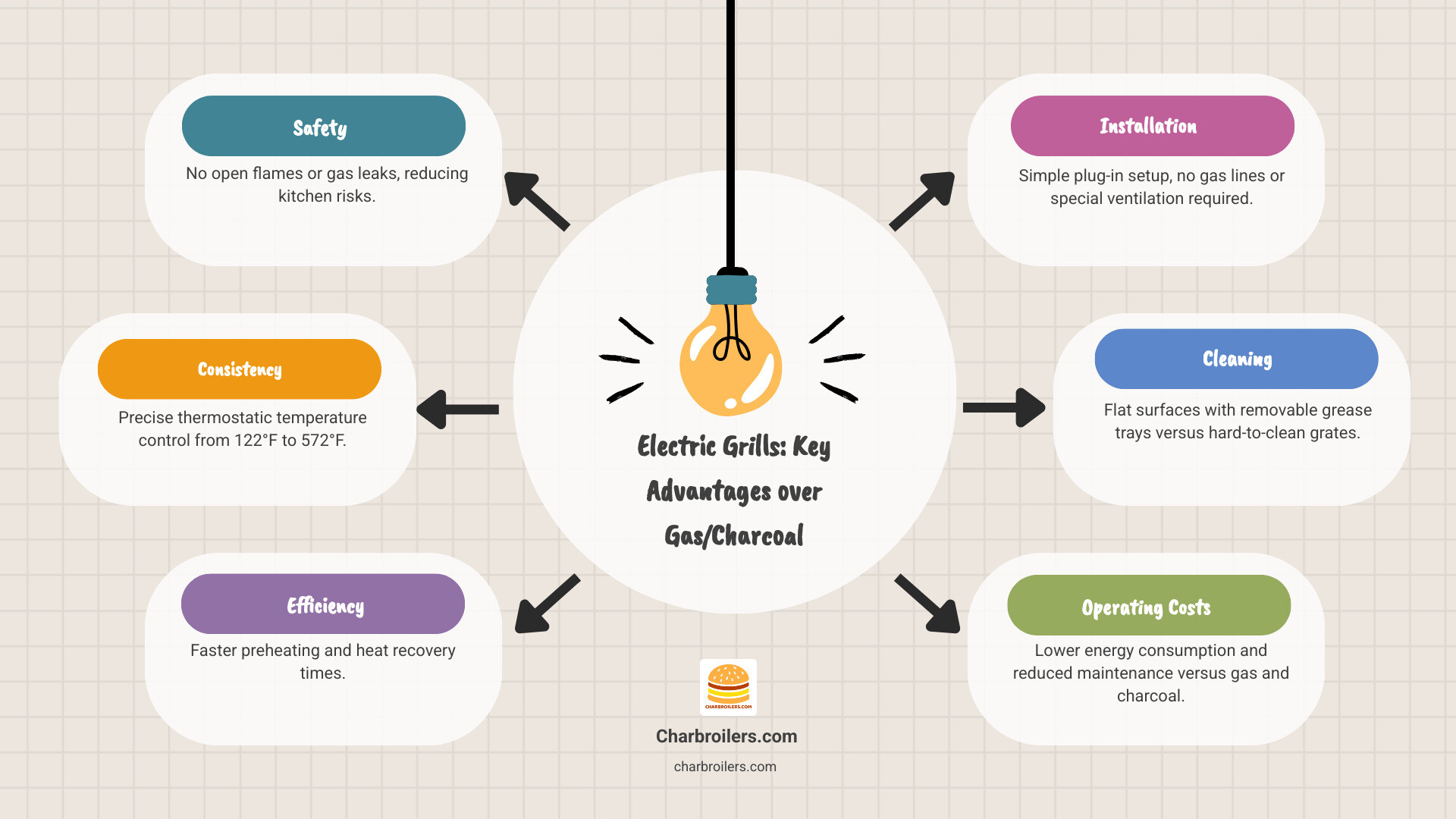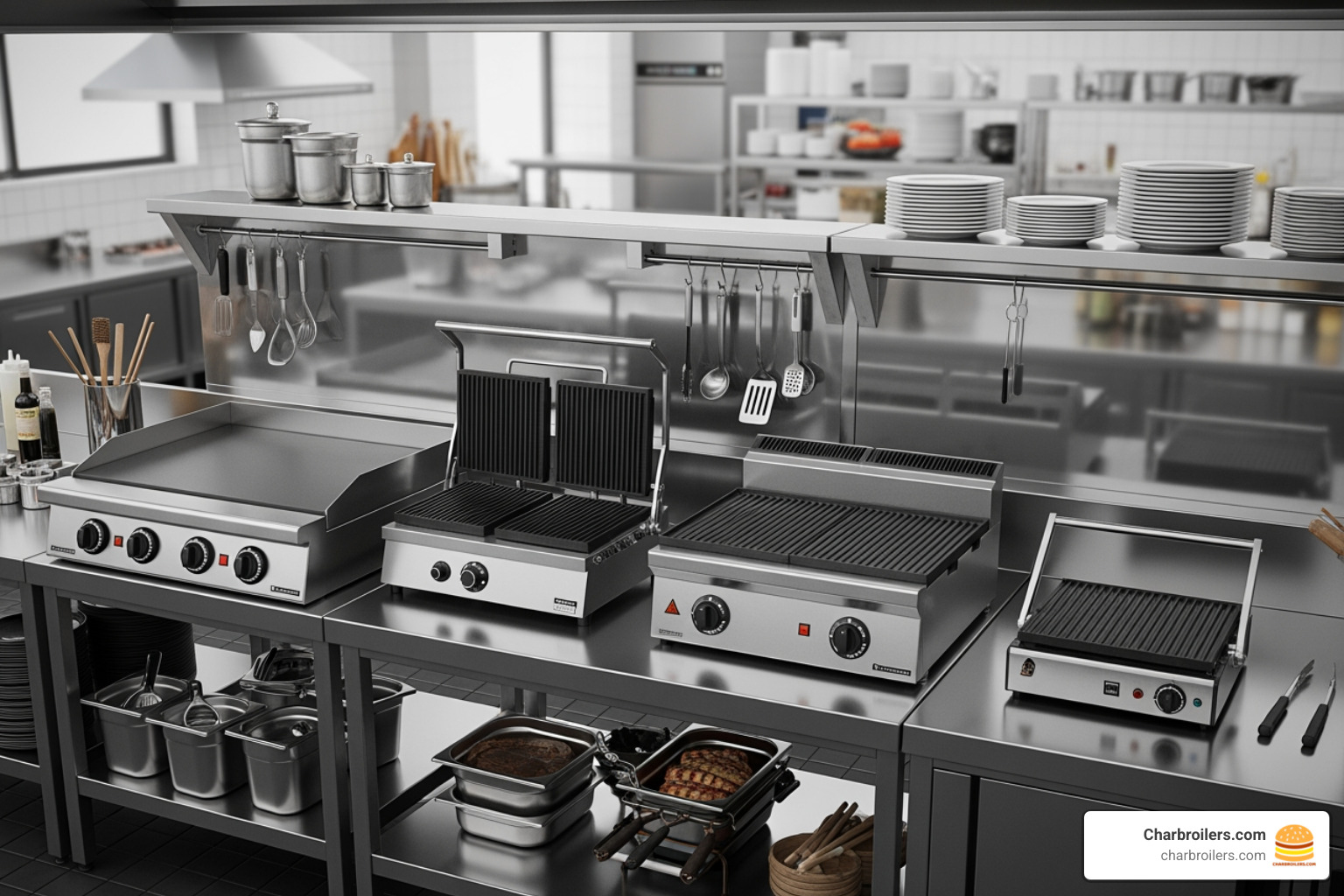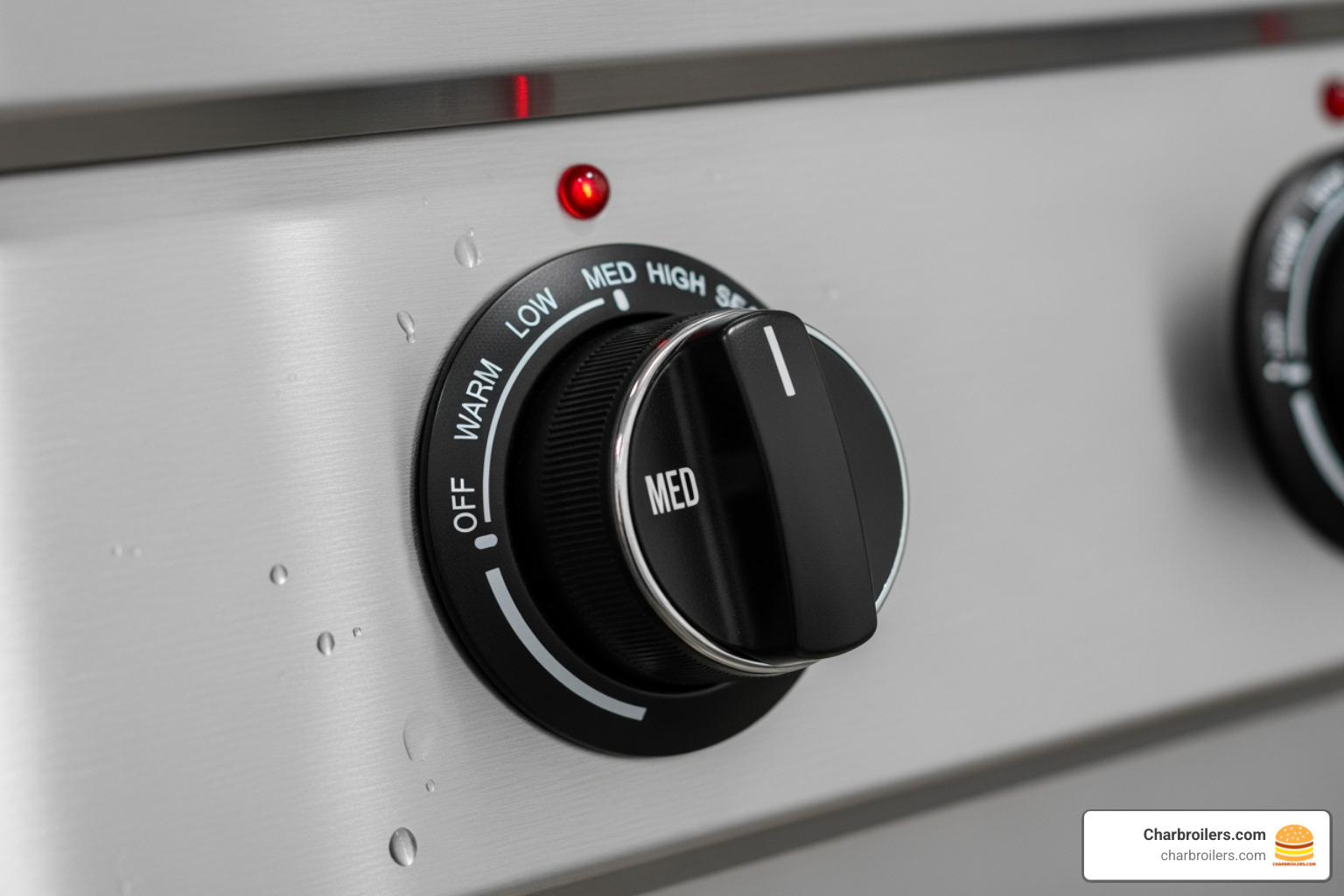
Power Up Your Profits: Best Commercial Indoor Electric Grills & Griddles
Share
Why Commercial Indoor Electric Grills Matter for Your Restaurant's Success
A commercial indoor electric grill offers a safer, more consistent alternative to gas and charcoal. With no open flames, precise temperature control, and minimal ventilation needs, they are ideal for high-volume indoor cooking.
Top Benefits:
- Smokeless operation - No open flames or heavy emissions
- Consistent temperature - Even heat distribution
- Easy installation - Plug-and-play setup
- Lower operating costs - More energy-efficient than gas
- Simple cleaning - Flat surfaces and removable grease trays
- Versatile cooking - From pancakes to steaks
The commercial cooking equipment market is projected to reach $51.9 billion by 2030, with electric griddles leading this growth (5.5% CAGR) due to demand for safer, versatile equipment.
As Tanya B from Buffalo, WY puts it: a commercial griddle is "the ultimate culinary workhorse" essential for restaurant success. When facing limited space, tight budgets, and the need for consistency during rush hour, the right commercial indoor electric grill is critical.
Electric grills eliminate open-flame risks while delivering high-volume performance. They preheat faster, maintain consistent temperatures, and handle frozen food without losing heat during peak service.
I'm Sean Kearney from Charbroilers.com. With over a decade in the restaurant equipment industry, I've helped countless kitchens boost efficiency and profits with the right electric grill. This guide will walk you through everything you need to know to make the best choice.

Handy commercial indoor electric grill terms:
Why Go Electric? Key Benefits for Your Commercial Kitchen
In a busy restaurant, you need equipment that works with you. A commercial indoor electric grill delivers reliable performance without the headaches of gas or charcoal.
Safety is the top benefit. Electric grills have no open flames, eliminating fire hazards. With no pilot lights or gas leaks to worry about, your staff can focus on cooking. This peace of mind is invaluable, especially in smaller kitchens or buildings with strict fire codes.
Electric grills also mean reduced emissions. With no gas or charcoal combustion, your kitchen air is cleaner, your ventilation system works less, and your team breathes easier. This is crucial in space-constrained environments.
Electric models offer consistent temperature control, distributing heat evenly across the entire cooking surface for predictable results every time. No more hot spots that lead to unevenly cooked food.
Energy efficiency translates directly to your bottom line. Electric grills convert nearly all their energy into heat on the cooking surface, with less waste. Over time, these lower operating costs add up to real savings.
Installation is simple. Most commercial indoor electric grills offer true ease of installation—just plug them into the right outlet. There's no need for a licensed gas fitter or new gas lines, giving you more flexibility in your kitchen layout.
Electric grills also feature faster preheating and quick recovery times. The temperature bounces right back after you add frozen food, keeping your throughput high and customers happy during peak hours.
For restaurants looking to upgrade their cooking capabilities without the complexity of gas systems, switching to electric just makes sense. Want to explore more equipment options for your kitchen? Check out our guide on commercial kitchen appliances.
Types of Commercial Indoor Electric Grills
There are several types of commercial indoor electric grills, each designed for specific tasks. Understanding them helps you choose the perfect one for your kitchen.

From flat-tops for the breakfast rush to charbroilers that deliver perfect grill marks, the right commercial indoor electric grill can transform your workflow. Let's review the main types.
Flat-Top Griddles & Grills
The electric flat-top griddle is the workhorse of commercial kitchens. Its versatile surface handles everything from breakfast items like pancakes and eggs to lunch and dinner service, searing steaks, flipping burgers, and sautéing vegetables. With no grates, you can manage multiple items at once. The even heat distribution eliminates hot spots, and excellent heat retention is crucial for handling high volumes of cold or frozen ingredients during peak service. Check out a popular high-rated flat top griddle to see what these workhorses can do.
Contact & Clamshell Grills
For maximum speed, contact and clamshell grills cook food from both sides at once, cutting cooking times nearly in half. Contact grills, or Panini presses, are perfect for hot, crispy sandwiches and paninis. You can choose between ribbed plates for grill marks or smooth plates for a uniform finish.
Clamshell griddles are even more efficient for high-volume cooking. A top platen lowers onto the food, using dual-sided heating to cook dozens of chicken breasts or burgers without flipping. These grills' faster cooking times are a lifesaver during busy rushes.
Electric Charbroilers
Electric charbroilers deliver authentic charbroiled flavor and gorgeous grill marks indoors, without needing gas lines or heavy-duty ventilation. They create a distinctive smoky flavor when drippings from steaks, seafood, or vegetables hit the heated elements below. This infuses food with a classic grilled taste. The precise temperature control allows you to sear a thick steak or gently cook delicate fish. You get all the benefits of traditional charbroiling without the complexity of gas or charcoal.
Want to dive deeper? Visit our guide on electric charbroiler commercial models, or learn more about commercial electric charbroilers.
The Ultimate Buyer's Guide: Features to Look For
Choosing the right commercial indoor electric grill is a key decision for your kitchen's efficiency. It requires understanding the features that will serve your needs and ensure durability.

The cooking surface material is a critical factor. Understanding the differences is crucial for your investment.
| Material | Pros | Cons | Best For | Maintenance |
|---|---|---|---|---|
| Stainless Steel | Durable, corrosion-resistant, professional appearance, easy to clean | Can be prone to sticking without proper seasoning, may develop hot spots | High-volume kitchens, versatile cooking applications | Daily wipe-down with degreaser, periodic deep cleaning |
| Cast Iron | Excellent heat retention and distribution, naturally non-stick when seasoned, imparts slight flavor | Heavy, requires regular seasoning, can rust if not maintained | Steaks, burgers, anything needing consistent high heat | Season regularly, avoid harsh detergents, dry immediately |
| Chrome | Highly responsive to temperature changes, smooth non-stick surface, easy cleaning | Less durable than steel or iron, can chip or peel over time | Delicate foods like eggs and pancakes, breakfast service | Gentle cleaning only, avoid metal utensils and abrasive scrubbers |
While stainless steel bodies are the industry standard for durability, the cooking plate material directly impacts performance and maintenance time.
Choosing the Right Size for a commercial indoor electric grill
Balance your available countertop space with your production volume needs. The cooking surface area ranges from compact 12-inch models for small cafes to 72-inch units for high-volume operations. A 24-inch or 36-inch model is often ideal for restaurants with steady customer flow and peak rushes. Smaller countertop units offer portability and flexibility, while larger built-in models provide stability and power. For more guidance on sizing, check out our roundup of different sized commercial charbroilers.
Power and Wattage for your commercial indoor electric grill
Electric grills run on either standard 120V or commercial 208/240V circuits. The voltage impacts wattage requirements, which affects heat-up time and recovery speed. While 120V units are convenient, 208/240V models deliver the power needed to maintain temperature during busy shifts. Before buying, verify your kitchen's electrical infrastructure with an electrician to ensure you have the proper circuits and amperage.
Temperature Control and Consistency
Thermostatic controls automatically maintain your set temperature, ensuring consistency. While some prefer manual controls, they require more experience. Look for a wide temperature range (e.g., 122°F to 572°F) to suit your menu and even heat distribution to prevent hot spots. A premium feature to consider is zoned heating, which allows you to set independent temperature zones on the same surface, boosting efficiency.
Material and Construction
A robust stainless steel body ensures durability and hygiene. Quality cooking plate material is key, but also look for features like non-stick surfaces, splash guards, and an effective grease management system with removable drip trays to simplify cleaning. Durability should be your guiding principle. For examples of well-built units, browse our selection of commercial electric griddles.
Why Electric Grills Are a Must-Have
For any commercial kitchen looking to maximize profits while navigating challenges like limited space, strict safety codes, or budget constraints, an electric grill is essential. It provides a safe, efficient, and versatile cooking solution that helps you succeed.
Types of Commercial Indoor Electric Grills
There are many types of commercial indoor electric grills, each with its own advantages and disadvantages. Here are some of the most popular:
The Ultimate Buyer's Guide: Features to Look For
Choosing the right commercial indoor electric grill is a big decision. Here are some key features to consider:
Maximizing Your Investment: Applications, Cleaning, and Safety
To get the most from your commercial indoor electric grill, use it to expand your menu, maintain it for longevity, and follow safety protocols to protect your team.
Menu Versatility and Applications
One of the best aspects of a commercial indoor electric grill is its versatility across all day-parts. For breakfast service, it's indispensable for pancakes, eggs, and bacon. At lunch, it effortlessly handles burgers, grilled sandwiches, and quesadillas. For dinner service, it excels at searing steaks, fish, and vegetables with precise temperature control.
Beyond traditional fare, electric grills open the door to ethnic cuisines. Teppanyaki-style cooking, French crepes, or Korean bulgogi become menu possibilities. This versatility allows you to test limited-time offers and seasonal specials without new equipment. Adding grilling capability without gas lines is a game-changer for menu development and appealing to health-conscious diners. For more ideas, check out our guide on commercial kitchen equipment.
Maintenance and Cleaning Requirements
Proper maintenance is key to your grill's longevity, and it's straightforward. Daily cleaning is non-negotiable. While the griddle is still warm, scrape the surface to remove residue, then use a commercial degreaser and wipe clean. The flat surface of most electric grills makes this much easier than cleaning grates.
Seasoning your griddle (for steel or cast iron) is also essential. After cleaning, apply a thin layer of high-smoke-point oil to the warm surface to create a natural non-stick finish and prevent rust.
Don't forget the removable grease trays. Empty and clean them daily to prevent fire hazards and maintain sanitation. Always use non-abrasive cleaners and tools appropriate for your cooking surface, and check the manufacturer's recommendations.
Essential Safety Considerations
Electric grills are safer than gas, but safety protocols are still essential. Proper ventilation via your kitchen's exhaust hood is still important to handle smoke and steam. For electrical safety, ensure your circuits can handle the unit's power requirements and never use extension cords. Have a licensed electrician verify your setup.
To prevent burns, train staff to treat all surfaces as hot and use clear communication. Look for units with non-slip feet for stability and overheating protection for an extra layer of safety. Finally, keep the area around the grill clear of combustible materials like towels and packaging.
Frequently Asked Questions about Commercial Electric Grills
Here are answers to the most common questions about commercial indoor electric grills to help you make a confident decision.
What is the average price range for commercial indoor electric grills?
The price of a commercial indoor electric grill varies based on size, material quality, and features. Entry-level models (often smaller countertop units) start around $500 to $1,000. Mid-range units, the sweet spot for many restaurants, fall in the $1,000 to $2,500 range, offering better construction and controls. High-end equipment with advanced features and maximum durability can run from $2,500 to $5,000 or more.
At Charbroilers.com, we offer financing options to help make these investments more manageable for your business.
Which features should I look for in a commercial indoor electric grill?
When shopping, focus on features that ensure performance and longevity. Look for a reputation for durability, as your grill needs to withstand daily use. Innovation in temperature control, such as responsive thermostats or multiple heat zones, makes a real difference in a busy kitchen.
The importance of warranty cannot be overstated; it protects you from repair costs. Good after-sales support is also crucial for quick help when needed.
Key features to look for include:
- ENERGY STAR® certification for energy efficiency.
- NSF certification for sanitation and safety.
- Heavy-duty construction (e.g., commercial-grade stainless steel).
- Precise temperature controls.
- Removable grease management systems for easy cleaning.
- Quick heat-up and recovery times to maintain service speed.
How can a commercial indoor electric grill improve my menu?
An electric grill can significantly expand your menu possibilities. It adds grilling capability without gas lines, which is ideal for locations with installation restrictions. This enables new menu items like pressed paninis, grilled salmon, or even teppanyaki-style dishes.
Electric grills provide consistent results for quality control, ensuring every dish meets your standards and reducing food waste. They also support healthy cooking options, as you can cook with minimal fat, appealing to health-conscious diners. Finally, their flexibility supports limited-time offers and seasonal menu changes, allowing you to stay agile and keep your menu fresh.
For more comprehensive guidance, check out our Explore the ultimate guide to commercial charbroilers for your restaurant.
Conclusion
Investing in the right commercial indoor electric grill is a smart decision for any successful commercial kitchen. These versatile workhorses deliver on what matters most: safety without open flames, consistent temperature control for reliable results, and the versatility to handle your entire menu.
Electric grills offer simplicity: no complex gas lines, easier cleaning, and dependable performance during the busiest shifts. Whether you need a flat-top griddle, a contact grill, or an electric charbroiler, there is a model perfectly suited to your needs.
At Charbroilers.com, we understand that choosing the right equipment is about finding solutions that help your business grow. We offer expert guidance and financing options designed for food service operations. We're not just selling equipment; we're partnering with you to build a more efficient, profitable kitchen.
Ready to take the next step? Our team is here to help you find the perfect commercial indoor electric grill. For more resources, don't miss our comprehensive guide: Explore the ultimate guide to commercial charbroilers for your restaurant.
